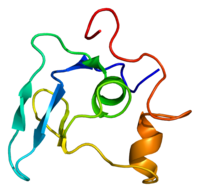Marfan lipodystrophy syndrome
| Marfanoid–progeroid–lipodystrophy syndrome | |
|---|---|
 |
|
| A mutation in the protein profibrillin, encoded by FBN1, is the cause of Marfanoid–progeroid–lipodystrophy syndrome. | |
| Classification and external resources | |
| ICD-10 | E88.1 |
| OMIM | 616914 |
| Orphanet | 300382 |
Marfanoid–progeroid–lipodystrophy syndrome (MPL), also known as Marfan lipodystrophy syndrome (MFLS) or progeroid fibrillinopathy, is an extremely rare medical condition which manifests as a variety of symptoms including those usually associated with Marfan syndrome, an appearance resembling that seen in neonatal progeroid syndrome (NPS; also known as Wiedemann–Rautenstrauch syndrome), and severe partial lipodystrophy. It is a genetic condition that is caused by mutations in the FBN1 gene, which encodes profibrillin, and affects the cleavage products of profibrillin, fibrillin-1, a fibrous structural protein, and asprosin, a glucogenic protein hormone. As of 2016, fewer than 10 cases of the condition have been reported.Lizzie Velasquez and Abby Solomon have become known publicly through the media for having the condition.
In addition to severe lipodystrophy (loss of adipose tissue), individuals with MPL show a concomitant marked loss of lean tissue mass, which also contributes to their "skinny" appearance. Based on visual inspection, it was originally thought that the lipodystrophy associated with MPL was generalized. However, it appears in fact to be partial, being confined to the face, distal extremities, and the and lateral regions of the . Normal amounts of subcutaneous fat are found in the torso over the chest and abdomen. As such, the breasts are normal in females with MPL.
...
Wikipedia
